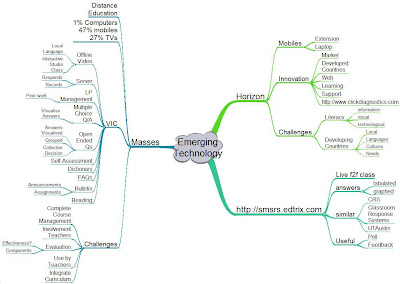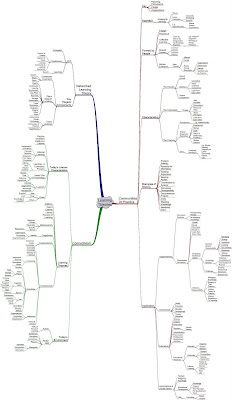My Blog List
Monday, September 27, 2010
Virtual Seminar: Critique & Review of Electronic Portfolio
The purpose and goals of the portfolio
I have been working with the only ODL institution in Bangladesh, Bangladesh Open University (BOU). BOU mainly uses printed materials in conducting courses, with a few supplementary audio and video recorded lessons. One of its popular courses is English language. English language is a core subject in most faculties at BOU. As an assessor of English examination papers, I have found it difficult to trace noticeable progress in authentic usage of English language. Learners in most of the cases produce the bits of knowledge they have memorized. As a language instructor, it appears as a challenge to me to provide the learners with a constructive learning environment in an ODL environment. To assist learners with a congenial, encouraging, creative learning opportunities, BOU attempted to prepare pre-recorded interactive programmes on English language learning, called Virtual Interactive Classroom (VIC, http://www.electronicgovernment.se/bvc/hsc2e.html), which to some extent provided learners with an active learning environment. And I thank Allah for creating an opportunity to be exposed to the world of learning through MIDT with which I would like to reform and recreate a learning environment supported by strong pedagogy served by web 2.0 technology.
The purpose of the e-portfolio will be to
i. demonstrate the effectiveness of IDT through my own learning in chosen artifacts and that it is something that may be considered by BOU for making English language teaching more effective.)
ii. promote active and interactive pedagogy in English language learning where e-technology has tremendous roles to play.
Outcomes to be addressed in the portfolio
1. To demonstrate the role of reflection in learning
2. To demonstrate the need for Instructional Design in Language Learning.
3. The role of regular feedback in learning progress
4. The role of visual support/ visual learning objects in learning
5. Teacher-student, student-student, student-resources interactions and contribution in learning
6. Role of e-technology in reflection, feedback, visual support and interactions
Target audience
My MIDT classmates and my colleagues at Bangladesh Open University ( BOU) are the target audience of the e-portfolio. I will provide my faculty with the blog link so that they can have an access to go through it,and share their views for academic and professional development.
List of artefacts to be included from the following courses
1.Principles and Practices of Instructional Design (1 artefact)
2. Research In Instructional Design & Technology (1 artefact)
3. Applying Theories of Learning to Instructional Technology (1 artefact)
4. Managing Intellectual Capital (2 artefacts)
5. Learning Community and Social Pedagogical Networks (1 artefact)
6. Design & Development of Interactive e-learning (2 artefacts)
7. Online Instructional Assessments (1 artefact)
8. Instructional Technology Development Tools (1 artefact)
9. Human Performance Technology (1 artefact)
10. Current Trends & Issues In Instructional Technology (2 artefacts)
11. Research Project Design (capstone project)
12. Virtual Seminar (blog)
Research project design (Capstone project)
My capstone project is on using Wiki in an undergraduate class of English Language Training.
The teaching and learning of English as a second language (ESL) in Bangladesh has been facing severe problems, so much so that language learning follows behaviorism principals, i.e. even essays are memorized and reproduced in exams. Given this backdrop, students who join the university after 12 years of schooling find it difficult to write correct English sentences. This project work reports on the efforts to support undergraduate students, participating in a regular face-to-face class English Language Teaching (ELT) class, with wiki based assignments, with the purpose of getting them to reflect on solving the language teaching problems that they face. Unfortunately, the students attending the ELT classes are themselves weak in English. It was found that getting students to participate in wiki work is difficult for a variety of reasons. Some students participated fully and others simply read the assignments of others in the wiki but did not participate by writing. From the case studies evaluated, it was found that students who had a positive attitude towards the newly introduced pedagogy in class, demonstrated more reflection compared to their peers who only very reluctantly participated in the Wiki. Overall, support of the wiki helped students demonstrate a degree of reflection not normally demonstrated in class. This helped in better thinking about English Language syllabus design to a degree.
Before engaging students in Wiki,students were to prepare an ESL syllabus (a video of student presentation has been uploaded here)using their own learning experiences and presented then in class.
Instructional Technology Development Tools
I had zero knowledge on HTML, and Dr Ravi, the course facilitator with his unlimited patience instructed and guided me in completing the project. As this is a practical work I need to practice more for getting fluency in HTML. But I assess educational webs as a very useful tool in facilitating learning.
If instructional designers can have the efficiency on web designing, they can build webs according to the needs of learners, and instructors as well.
Applying Theories of Learning to Instructional Technology

The course Applying Theories of Learning to Instructional Technology (HMLT 5203) combined various learning theories, behaviourism, cognitivism, constructivism, and connectivism with technology to have an effective delivery in education. The task of preparing a position paper (artifact) was an introductory lesson for me with web 2.0 tools. I was amazed to see the numbers and uses of web 2.0 tools. Later on, in the 4th semester through HMID 6303 we were exposed to innumerable tools that can be applied to add multidimensional effects to learning. Bonk's book The World Is Open opened the world for learning community where geographical boundary does not exist.
Now I can hardly think of any educational programme without web 2.0 tools.
I have selected the artifact as I want to share my experience with my colleagues, and would like to learn how they are using web tools in professional life.
Sunday, September 26, 2010
Instructional Design & Technology

For Task 2 (artifact) of Research In Instructional Design & Technology (HMIR 5103)we were to locate a primary source research report. We were introduced with taxonomies for technology in Chapter: T (Caladine, 2008)and relate an appropriate taxonomy with the report selected.We were to go deeper into taxonomies of education. And then show how the report fits with one or more of the taxonomies. I suppose this was the research orientation that supported us conducting the capstone project.
Familiarization with education and technology taxonomies are helping me in sequencing and organizing learning aspects and conducting classes as well.
The course introduced me with the basics of education technology vital for the current learning situation all over the world.
Instructional Design

One of the important tasks we were to do for HMID 5003 Principles and Practices of Instructional Design in the 1st semester was to prepare an appraisal on 'objectives in instructional design' (artifact). The assignment actually directed my attention towards the fact that as an instructional design the first and foremost task is to focus on 'objectives'. Since then I've observed, 'the best classes are those where the objectives have been negotiated with the students using a participatory method. If the students take ownership of the objectives then the learning outcomes essentially become a responsibility of the learner as the learner is motivated'.
I'd like learn from my MIDT mates how they are applying the theories on 'objectives' in professional life.
Learning Community & Social Pedagogical Networks

Right click to view the enlarged image
The final task (artifact) of the course Learning Community and Social Pedagogical Networks (HMLC 5303) takes me to think deeper of the learning theories. In the task I used an example of bees, If we look at nature and focus on the example of the bees, the activities of worker bees’, skills
and decisions reflect wisdom of how to collect nectar and when to kill the male bees whose
job is no longer required, and how to protect the queen bees. Though the whole system is
programmed, don’t you think that the integrated nature of the task reminds us of connectivism-
--a learning theory that requires self organization, connections with members, with resources,
accomplishment? .
I was wondering while going through the theories of connectivism, networked learning, and communities of practice that in one word, can we say 'knowledge resides in connections?'
I seek your opinion about how can we strengthen connections to enhance our knowledge?
Managing Intellectual Capital
My MIDT friends and facilitators can suggest me solving intellectual capital crises in the BOU. I have prepared a power point that summarizes my original assignment (artifact) , so that viewers can have a quick look at it.
Saturday, September 25, 2010
Online Instructional Assessment
The idea of online assessment appeared effective to me, though I have not used it in my professional life. The tools Dr Robeck, and my classmates mentioned seem very exciting to me. I am planning to work with them in my next semester ELT course.
I am adding this assignment to better my ideas through comments from my classmates.
Current trends & Issues In Instructional Technology
The synthesized Chapter 3 (artifact) of Bonk's book, where the promises of e-learning is evident.
I intend that the policy makers, educationalists all over the world could see the proposal in Assignment 2 (artifact) , so that we could be assisted with more ideas and actions to move forward.
And, I look forward to share my classmates plans, experiences in this regard.
Technology & Intervention
Learning from Benjamin Bloom’s theories was even more substantiated by the course Human Performance Technology (HMHP 5903) that Dr Putri supervised. It has become easy for me to classify performance level, thinking order of learners, identify and analyse weaknesses in management and learner performances, and to select a suitable performance intervention.
For the 2nd assignment we were required to select one performance intervention for the performance problems identified in the Bangladesh Open University. The power point for this course helped me focus on performance support systems, job analysis/ work design, personal and human resources development, organizational design and development. Viewing this power point, I want my classmates to add their perspectives to the problems and solutions in my organization.